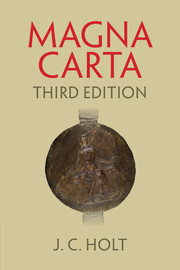Book contents
- Frontmatter
- Dedication
- Contents
- List of plates
- Preface to third edition
- Preface to second edition
- Preface to first edition
- Acknowledgements
- Abbreviations
- Introduction
- 1 The Charter and its history
- 2 Government and society in the twelfth century
- 3 Privilege and liberties
- 4 Custom and law
- 5 Justice and jurisdiction
- 6 Crisis and civil war
- 7 Quasi Pax
- 8 The quality of the Great Charter
- 9 The achievement of 1215
- 10 From distraint to war
- 11 The re-issues and the beginning of the myth
- Appendices
- 1 The meeting at Bury St Edmunds, 1214
- 2 Notification of Thomas count of Perche, February 1215
- 3 Triplex forma pacis
- 4 The ‘unknown’ charter
- 5 The Articles of the Barons
- 6 Magna Carta, 1215
- 7 Translations of the Charters
- 8 The Twenty-Five barons of Magna Carta, 1215
- 9 The date of the London treaty
- 10 The Oxford Council, 16–23 July 1215
- 11 Select documents illustrative of the history of Magna Carta, 1215
- 12 Magna Carta, 1225
- 13 Charter of the Forest, 1225
- 14 Liberties and perpetuity
- References
- Index
- Plate section
4 - The ‘unknown’ charter
from Appendices
Published online by Cambridge University Press: 05 July 2015
- Frontmatter
- Dedication
- Contents
- List of plates
- Preface to third edition
- Preface to second edition
- Preface to first edition
- Acknowledgements
- Abbreviations
- Introduction
- 1 The Charter and its history
- 2 Government and society in the twelfth century
- 3 Privilege and liberties
- 4 Custom and law
- 5 Justice and jurisdiction
- 6 Crisis and civil war
- 7 Quasi Pax
- 8 The quality of the Great Charter
- 9 The achievement of 1215
- 10 From distraint to war
- 11 The re-issues and the beginning of the myth
- Appendices
- 1 The meeting at Bury St Edmunds, 1214
- 2 Notification of Thomas count of Perche, February 1215
- 3 Triplex forma pacis
- 4 The ‘unknown’ charter
- 5 The Articles of the Barons
- 6 Magna Carta, 1215
- 7 Translations of the Charters
- 8 The Twenty-Five barons of Magna Carta, 1215
- 9 The date of the London treaty
- 10 The Oxford Council, 16–23 July 1215
- 11 Select documents illustrative of the history of Magna Carta, 1215
- 12 Magna Carta, 1225
- 13 Charter of the Forest, 1225
- 14 Liberties and perpetuity
- References
- Index
- Plate section
Summary
The ‘unknown’ charter survives in the Archives Nationales in Paris where it is classified as J. 655 in the Archives du Royaume. It was printed by Teulet in his edition of the Layettes in 1863, but was not known to English historians until it was discovered by J. H. Round in 1893: hence its name. It has formed part of the French royal archives since the thirteenth century along with two copies of the Magna Carta of 1216.
The document consists of a copy of the charter of liberties of Henry I to which certain concessions by John have been added. The provenance of the document and the form ‘Edouardus’ suggest that it was the work of a Frenchman. When he produced it is uncertain, but, whatever the date, it is clear that he was copying for he made errors of repetition in transcribing which he subsequently corrected.Whether he was copying from a document which already associated Henry I's charter with additional concessions by John, or whether the copyist himself associated the two for the first time in this document cannot be determined. His errors were not limited to repetition. His text of Henry I's charter contains several omissions and variants. This must be kept in mind in evaluating the second part of the document.
Authenticity
The main objection to accepting this document as an authentic grant or even as a memorandum of an authentic grant lies in the archaism of the language used in listing John's concessions. The use of the third person and even more the first person singular were totally foreign to John's Chancery; nor do the words baiulare, decenter, pecudes occur frequently in formal documents of the Crown in the senses used here.
On the other hand the text of the Charter of Henry I is independent of but similar to those of the twelfth-century law-book Quadripartitus and the Red Book of the Exchequer.
- Type
- Chapter
- Information
- Magna Carta , pp. 345 - 355Publisher: Cambridge University PressPrint publication year: 2015



